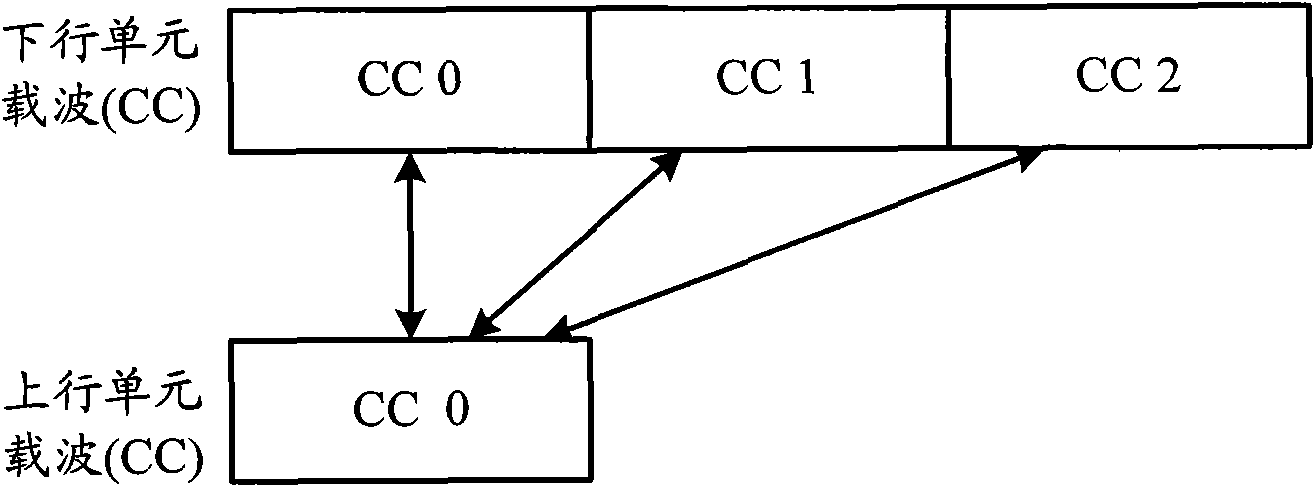Method for determining acknowledgement (ACK)/negative acknowledgement (NACK) channel
A technology for determining methods and channels, applied in wireless communication, error prevention/detection using return channels, digital transmission systems, etc., can solve the problems that ACK/NACK channels cannot be used evenly, unfavorable scheduling flexibility, etc., to improve scheduling The effect of flexibility
- Summary
- Abstract
- Description
- Claims
- Application Information
AI Technical Summary
Problems solved by technology
Method used
Image
Examples
no. 1 example
[0023] Such as image 3 As shown, in order to reduce the overhead of the PDCCH, this embodiment does not add identification information used to distinguish the ACK / NACK channel mapped by the PDCCH in the PDCCH, but completely according to the index of the CCE contained in the current PDCCH, the index of the downlink CC where the PDCCH is located and The number of ACK / NACK channels in the uplink CC determines the ACK / NACK channel mapped by the PDCCH. The reason why this embodiment uses the index of the downlink CC where the PDCCH is located is mainly to ensure that PDCCHs in different downlink CCs are mapped to different ACK / NACK channels on the uplink CC.
[0024] In this embodiment, assuming that the CCE on a downlink CC where the current PDCCH is located does not need to be mapped to continuous ACK / NACK channels in the uplink CC, the determination of the ACK / NACK channel mapped by the current PDCCH in this embodiment specifically includes:
[0025] First, distribute the CCE...
no. 2 example
[0080] This embodiment is different from the first embodiment. In order to further improve flexibility, this embodiment can further determine the current PDCCH mapping based on the information b used to indicate the offset value used when the CCE contained in the current PDCCH is mapped to the ACK / NACK channel. ACK / NACK channel, where the information b can be carried by the PDCCH, specifically adding information b to distinguish the mapped ACK / NACK channel in the PDCCH, or using other methods to inform the terminal that needs to determine the ACK / NACK channel mapped by the current PDCCH, here Not specifically limited.
[0081] For ease of description, this embodiment takes the information b carried by the PDCCH as an example. Based on this, when determining the ACK / NACK channel mapped by the CCE in this embodiment, it can be based on the index of the CCE contained in the PDCCH and the information b carried, combined with the current There is a formula for calculating the ACK / N...
no. 3 example
[0128] Compared with the above-mentioned first and second embodiments, this embodiment is relatively simple, specifically: when the ACK / NACK channels corresponding to the PDCCHs of multiple downlink CCs are sent on the same CC, as Figure 7 As shown, two groups of ACK / NACK channels are allocated on the uplink CC, and the first group of ACK / NACK channels has a one-to-one mapping relationship with the CCEs of the downlink CC designated as the primary downlink CC. In this way, the primary For the HARQ transmission of LTE UEs and higher-level UEs in the downlink CC, it should be noted that the method defined in LTE for mapping ACK / NACK channels to CCEs can be used to meet backward compatibility; and the second group of ACK / NACK channels is the same as CCE mapping of other downlink CCs other than the primary downlink CC. Based on this, determining the mapped ACK / NACK channel in this embodiment specifically includes: first determining whether the CC where the current PDCCH is located...
PUM
 Login to View More
Login to View More Abstract
Description
Claims
Application Information
 Login to View More
Login to View More - R&D
- Intellectual Property
- Life Sciences
- Materials
- Tech Scout
- Unparalleled Data Quality
- Higher Quality Content
- 60% Fewer Hallucinations
Browse by: Latest US Patents, China's latest patents, Technical Efficacy Thesaurus, Application Domain, Technology Topic, Popular Technical Reports.
© 2025 PatSnap. All rights reserved.Legal|Privacy policy|Modern Slavery Act Transparency Statement|Sitemap|About US| Contact US: help@patsnap.com



